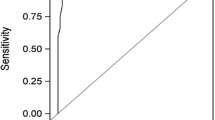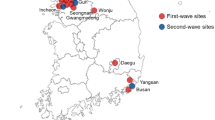Abstract
We postulate that most patients with chronic cough have a single discrete clinical entity: Cough Hypersensitivity Syndrome. We constructed a questionnaire that elicits the major components of the syndrome. Here we describe the validation of this questionnaire. Following iterative development, the Hull Airway Reflux Questionnaire (HARQ) was administered to patients and normal volunteers. It is self-administered and comprises 14 items with a maximum score of 70. Unselected patients were recruited sequentially from the Hull Cough Clinic. Preclinic questionnaires were compared with those obtained at the clinic. Responsiveness was assessed 2 months after the clinic visit. One hundred eighty-five patients and 70 normal volunteers were included in this study. There was a marked difference in HARQ scores between patients with chronic cough and normal volunteers. The sensitivity (94%) and specificity (95%) of the HARQ was high, with an area under the ROC curve of 0.99. All items of the scale significantly correlated positively with others in the scale and with the total score. On repeatability testing using Cohen’s kappa with quadratic weights, significant agreement was noted for all items. Good correlation was observed between the total scores (r = 0.78). The questionnaire was also responsive to treatment; the minimum clinically significant change was estimated to be 16 points. We have demonstrated the HARQ to have good construct and criterion validity. It is both reproducible and responsive to change. It can be used as a diagnostic instrument and demonstrates that chronic cough represents a single coherent entity: Cough Hypersensitivity Syndrome.





Similar content being viewed by others
References
Irwin RS, Corrao WM, Pratter MR (1981) Chronic persistent cough in the adult: the spectrum and frequency of causes and successful outcome of specific therapy. Am Rev Respir Dis 123:413–417
Corrao WM, Braman SS, Irwin RS (1979) Chronic cough as the sole presenting manifestation of bronchial asthma. N Engl J Med 300:633–637
Brightling CE, Ward R, Goh KL, Wardlaw AJ, Pavord ID (1999) Eosinophilic bronchitis is an important cause of chronic cough. Am J Respir Crit Care Med 160:406–410
Irwin RS, Pratter MR, Holland PS, Corwin RW, Hughes JP (1984) Postnasal drip causes cough and is associated with reversible upper airway obstruction. Chest 85:346–352
Avidan B, Sonnenberg A, Schnell TG, Sontag SJ (2001) Temporal associations between coughing or wheezing and acid reflux in asthmatics. Gut 49:767–772
McGarvey LPA (2005) Idiopathic chronic cough: a real disease or failure of diagnosis. Cough 1:9
Millqvist E, Bende M, Lowhagen O (1998) Sensory hyperreactivity—a possible mechanism underlying cough and asthma-like symptoms. Allergy 53:1208–1212
Kastelik JA, Thompson RH, Aziz I, Ojoo JC, Redington AE, Morice AH (2002) Sex-related differences in cough reflex sensitivity in patients with chronic cough. Am J Respir Crit Care Med 166:961–964
Morice AH, Faruqi S, Wright CE, Thompson R, Bland JM (2009) The cough hypersensitivity syndrome: a distinct clinical entity. Thorax 64(Suppl 4):A151–A152 (abstract)
Faruqi S, Brook H, Hunter V, Fathi H, Morice AH (2009) Reproducibility and sensitivity of the Hull Reflux Cough Questionnaire (HRCQ). Am J Respir Crit Care Med 179:A5756 (abstract)
Everett CF, Morice AH (2007) Clinical history in gastroesophageal cough. Respir Med 101:345–348
Belafsky PC, Postma GN, Koufman JA (2002) Validity and reliability of the reflux symptom index (RSI). J Voice 16:274–277
Birring SS, Prudon B, Carr AJ, Singh SJ, Morgan MD, Pavord ID (2003) Development of a symptom specific health status measure for patients with chronic cough: Leicester Cough Questionnaire (LCQ). Thorax 58(4):339–343
French CT, Irwin RS, Fletcher KE, Adams TM (2002) Evaluation of a cough-specific quality-of-life questionnaire. Chest 121(4):1123–1131
Ford AC, Forman D, Moayyedi P, Morice AH (2006) Cough in the community: a cross sectional survey and the relationship to gastrointestinal symptoms. Thorax 61:975–979
Morice AH, Higgins KS, Yeo WW (1992) Adaptation of cough reflex with different types of stimulation. Eur Respir J 5:841–847
Morice AH (2002) Epidemiology of cough. Pulm Pharmacol Ther 15:253–259
Kelsall A, Decalmer S, McGuinness K, Woodcock A, Smith JA (2009) Sex differences and predictors of objective cough frequency in chronic cough. Thorax 64:393–398
O’Connell F, Thomas VE, Studham JM, Pride NB, Fuller RW (1996) Capsaicin cough sensitivity increases during upper respiratory infection. Respir Med 90:279–286
Author information
Authors and Affiliations
Corresponding author
Rights and permissions
About this article
Cite this article
Morice, A.H., Faruqi, S., Wright, C.E. et al. Cough Hypersensitivity Syndrome: A Distinct Clinical Entity. Lung 189, 73–79 (2011). https://doi.org/10.1007/s00408-010-9272-1
Received:
Accepted:
Published:
Issue Date:
DOI: https://doi.org/10.1007/s00408-010-9272-1




